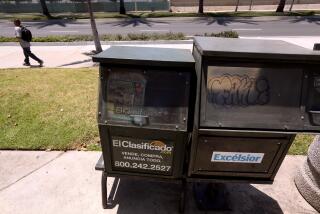A Close- Up Look At People Who Matter : Broadcasting the News for Blind Listeners
- Share via
The last printed words that Eugenie (Jolie) Mason read were a Dear Abby column in early 1986.
A magnifying glass and a bright light barely helped Mason make out the words just before a progressive eye disease robbed the last of her vision so she could no longer read the newspaper. “I missed the comics,” Mason said.
But then her job in the computer industry took her to Washington, D.C. There, for the first time, she heard comics, stories and other items being read over the radio. It changed her life.
Two years ago, Mason quit her job to create such a service.
“This was not the career I planned for,” said Mason, project director for the Los Angeles Radio Reading Service.
Two similar services had failed in the Los Angeles area.
“I’m determined that will not happen to us,” said Mason, 40, a cheerful Reseda woman who gives double hugs to new acquaintances, one for each side. She is guided by YUMA, a boisterous and friendly black Labrador whose name is an acronym for “Young Upwardly Mobile Animal.”
The Los Angeles Reading Service, broadcast out of a studio at Valley College in Van Nuys and carried on KCSN at Cal State Northridge, has 43 volunteers and four staff members who every weekday produce a two-hour radio show. They read the comics and news stories as well as columns, features, TV listings and grocery ads.
The program can only be picked up by radios specially adapted for the sub-carrier wave that feeds to KCSN. It restores a connection to the world lost by the 140,000 visually impaired people in Los Angeles.
“Newspapers are more in-depth, and more eclectic” than other TV and many radio programs, said Craig Massar, the development director who helps Mason run the reading service. Massar has retinitis pigmentosa and is legally blind.
“We shy away from O.J.,” said Stanley Dounn, the show’s editors. “No plane crashes or bombings.”
Dounn comes in well before the 9 a.m. broadcast to select and prepare the items to be read.
But a newspaper on radio does not necessarily make a natural match. Jon Dobrer of Encino, one of the volunteer readers, said he regularly trips over his tongue.
“Newspapers and magazines are the hardest things to read,” Massar said. “They’re not written to be read out loud.”
Since beginning its broadcasts in August, the service has gotten little feedback. One complaint was from a woman who believed the horoscope was demonic, Mason said. So they moved the disclaimer--that explains a horoscope is merely for entertainment--to the beginning of the report.
“We got one call saying our readers were as good as anywhere in the U. S.,” Mason said. “That meant a lot.”
When the Los Angeles readers are not broadcasting, the signal is used to rebroadcast the Minnesota Radio Reading Service, an organization of 500 volunteers broadcasting 24 hours a day. This is what Mason would like to see her service grow into.
She has made plans for reading ethnic newspapers such as La Opinion, the Sentinel, the Watts Times and the Korean Journal.
But she needs more volunteers, especially Spanish speakers, and funding.
Readers also described the Rose Bowl parade this year on the service.
“We describe the colors of the uniforms, the size and shape of the floats, the fabrics they wear,” said Sherry Haffenden, a volunteer reader from Canoga Park.
Those are the details that can help a blind person feel like a part of event, Mason said. Just as the reading service “keeps people together as if they are part of the community,” she said.
For more information call (818) 345-2874.
Personal Best is a weekly profile of an ordinary person who does extraordinary things. Please address prospective candidates to Personal Best, Los Angeles Times, 20000 Prairie St., Chatsworth, 91311. Or fax them to (818) 772-3338.
More to Read
Sign up for our Book Club newsletter
Get the latest news, events and more from the Los Angeles Times Book Club, and help us get L.A. reading and talking.
You may occasionally receive promotional content from the Los Angeles Times.









